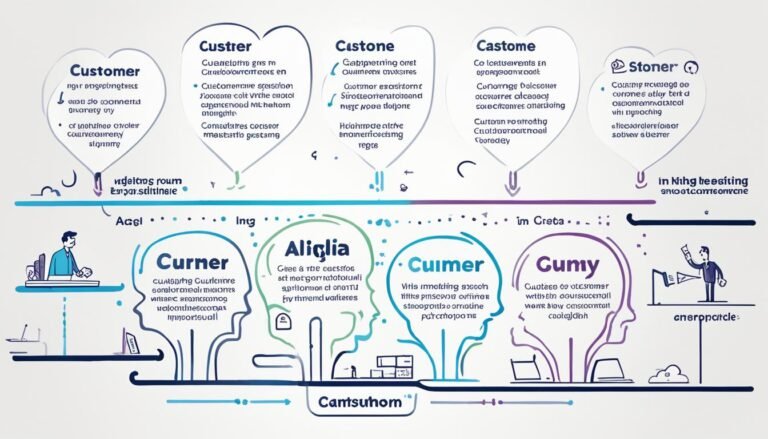STP Marketing: Segmentation, Targeting, and Positioning
Did you know that companies using the STP strategy can boost their marketing by 30%? The STP model is key in making marketing more personal. It helps businesses talk directly to their customers in a way that matters.
The STP model has three main steps: Market Segmentation, Market Targeting, and Product Positioning. These steps help businesses find and talk to the right people with the right message. By doing deep market research, companies can focus their marketing where it’s most effective.
In today’s digital world, using the STP model is a must. It lets businesses send out messages that really speak to their audience. By understanding what different customers want, companies can get more people to buy and engage more deeply.
Key Takeaways
- The STP marketing model stands for Segmentation, Targeting, and Positioning.
- STP marketing enhances the creation of personalized marketing communication plans.
- Effective segmentation leads to more focused and relevant marketing messages.
- Market targeting involves selecting segments with measurable differences and potential profitability.
- Positioning defines a strategic space for a product in the market, enhancing its appeal to targeted segments.
- STP is an integral part of the RACE Planning Framework, aiding in strategic marketing planning.
- Technological tools like Salesforce CDP help unify data and create highly targeted audience segments.
Understanding the Basics of STP Marketing
STP marketing stands for Segmentation, Targeting, and Positioning. It’s a key method in marketing. It helps businesses match their products with specific audience groups. This way, they can send out messages that hit the mark, making their marketing more effective.
What is STP Marketing?
STP marketing is all about three main steps: segmenting, targeting, and positioning. First, companies look at what makes their customers similar, like their age, where they live, and what they value. This helps brands like Nike and Apple know exactly who to sell to. Nike goes for young athletes, while Apple aims at those who love design and quality.
Next, they pick the best groups to target based on size, how different they are, if it’s worth it, and if they can reach them. For example, McDonald’s changes its menu to fit what people in different places like to eat. They focus on those who want good food but don’t spend a lot.
The Importance of STP in Modern Marketing
Using STP marketing is crucial today. Brands like Coca-Cola and Amazon use it to make marketing personal. Coca-Cola links its drinks to feelings like joy and family. Amazon predicts what customers might want and shows them products before they ask.
This approach helps brands use their marketing money better by focusing on the most promising groups. It makes messages more appealing to the target audience. By knowing what customers like, brands can offer experiences that keep them coming back. With 80% of shoppers sticking with brands that personalize their shopping, this method is key.
Market Segmentation: Identifying Your Target Audience
Market segmentation is key in STP marketing. It means finding and grouping potential customers by their traits. This makes sure each group is unique, needing its own marketing strategy, as Philip Kotler (1984) explains.
Segmentation helps a company stand out by guiding marketing efforts. It makes sure resources go to the right places. It also finds new customers and new uses for products.
Different Methods of Segmentation
There are many ways to segment the market, each giving a different view:
- Demographics: Uses age, gender, income, education, or job to group people.
- Psychographics: Looks at personality, beliefs, values, interests, and lifestyle.
- Lifestyle Segmentation: Groups people by their daily activities, interests, and opinions.
- Geographic Segmentation: Splits the market by location, like country, region, or city.
- Behavioral Segmentation: Groups customers by how they act, like how often they use a product or their loyalty.
The Role of Consumer Profiling in Market Segmentation
Getting to know your customers well is crucial for good segmentation. Tools like surveys, interviews, and data analysis help understand what they like and do. This lets businesses make detailed profiles of their customers.
Good segmentation makes marketing more efficient by focusing on the best areas. Tailoring marketing to each group’s needs improves customer connection. It also makes a brand stand out by sharing its unique benefits with the right people.
In short, market segmentation breaks a big market into smaller, distinct groups. Using demographics, psychographics, and lifestyle segmentation helps understand the market better. This leads to smarter marketing choices.
Effective Targeting Strategies
For businesses, picking the right target market is key to making the most of their marketing. This means selecting the right groups of people and checking if they match the brand’s goals. By focusing on the right groups, companies can make their marketing better and grow more.
Choosing the Right Market Segments
Choosing the right market segments is the first step. It’s important to know about the groups you’re looking at, like how big they are and how fast they’re growing. Target market selection should think about how easy it is to reach these groups and if they fit with what the company does best. Using data from research and what customers say helps find the best groups to focus on.
Evaluating Segment Potential and Commercial Attractiveness
After picking potential segments, it’s time to look at how good they are for business. This means finding segments that will bring in money and fit with the marketing plan. Important things to look at include how much money they could make, how big they are, who else is in the market, and how much it would cost to get customers. Using data helps put marketing efforts on the best segments, reducing risks and increasing profits.
Crafting a Positioning Strategy
Creating a strong positioning strategy is key. It begins with knowing your market through competitive analysis. Then, it moves to making a unique value proposition and product differentiation that speak to your audience.
Utilizing Competitive Analysis for Better Positioning
Competitive analysis is vital for brand positioning. It means looking at competitors to see what they do well and what they don’t. For example, Pepsi boosted its market share by using smart strategies against its competitors.
By studying the market, trends, and what customers want, businesses can make a strategy that stands out. This helps them offer something unique.
Creating a Unique Value Proposition
A unique value proposition (UVP) tells people what makes your product or service special. It meets the specific needs of your target audience. Pepsi saw a 14% jump in sales when it used smart marketing strategies.
This shows how a clear UVP can make a big difference. By talking directly to your audience and making products they love, you can make your brand more relevant and appealing.
Product Differentiation in Positioning
Being different is crucial in positioning. You can stand out with unique design, features, or amazing customer service. Research shows that 59% of customers shop based on personalization, and 44% would return if they got a personalized experience.
Companies that are great at making their products stand out can build loyalty and grow their market share. This gives them a big edge over competitors.
In short, a winning positioning strategy mixes competitive analysis, a strong value proposition, and product differentiation. This creates a brand that truly connects with its audience.
Building a Marketing Mix for Targeted Segments
Creating a marketing mix for specific groups is key in STP marketing. By segmenting, targeting, and positioning well, brands can grow more and make customers happier. This is better than just trying to reach everyone the same way.
Customizing Marketing Messages
To make the most of marketing mix development, it’s vital to tailor marketing messages for each group. Nike saw a 20% jump in revenue and a 30% rise in conversions by sorting customers into different groups. This customized marketing way helps brands meet specific needs and interests, making messages more engaging and relevant. A big 59% of customers say personalized experiences make them more likely to shop.
Ensuring Consistent Branding
Keeping a strong branding across all channels is also key in strategic marketing. It makes the brand feel unified and strengthens loyalty, which is crucial for lasting success. Research shows that 44% of customers say personalization makes them more likely to return. Having a consistent brand voice, look, and values across all platforms helps secure your place in the market and shapes how people see your brand.
By blending marketing mix development with tailored and consistent branding, companies can make big leaps in their marketing. A balanced approach leads to better market standing and a successful marketing outcome.
STP Marketing: Segmentation, Targeting, and Positioning in Digital Marketing
The digital world offers many ways to make STP marketing work better. Using tools like search engines, social media, and email helps target people more accurately. Data like what people search for and their interests helps a lot.
MarTech tools help marketers send messages that feel personal to many people at once. This is thanks to powerful personalization engines that use lots of data. With digital STP strategies, businesses can send content and offers that really match what people need and like. This makes marketing more effective and customers happier.
Leveraging Digital Channels for Better Targeting
Brands can now reach their audience very precisely through digital marketing channels. Tools like Google Ads and Facebook Ads let businesses make targeted digital campaigns. These use what people search for, their web history, and social media actions to find the right customers.
This way, ads get to the right people at the right time. It makes it more likely that people will buy something.
Utilizing MarTech Tools for Effective Personalization
MarTech has changed how businesses personalize online. Tools like HubSpot, Salesforce, and Adobe Experience Cloud help make experiences that fit what users like and do. They use data and learning machines to send content, product tips, and special deals that are just right for each person.
According to Accenture, 91% of shoppers like to buy from brands that know them and send them deals that matter. This shows how powerful making marketing personal can be.
Real-World Examples of Successful STP Marketing Campaigns
Brands have used STP strategies to connect with their audience. They’ve done this by analyzing the market and executing their plans well. This has led to success in health-conscious branding, eco-friendly products, and disrupting the market.
Panera Bread’s Health-Conscious Positioning
Panera Bread targets health and climate-conscious people in the fast-casual dining world. They offer high-quality, nutritious meals that match what customers want. This has made Panera a top choice for those looking for healthy food, showing a big win in the food industry.
The Success of AllBirds’ Eco-Conscious Branding
AllBirds stands out in the shoe market by focusing on sustainability. They use natural materials for their shoes, showing their dedication to eco-friendly products. This has attracted customers who care about the environment, proving the power of targeted STP marketing.
Innovative Positioning by Billie in the Razor Market
Billie has changed the shaving industry by challenging old ideas about gender and beauty. They target women and focus on being cost-effective and positive about the body. This bold move has won over customers who want real value and honesty, showing how new ideas can build strong brand loyalty and market share.
Practical Steps to Implement STP Marketing in Your Business
Starting with STP implementation in your business is a step-by-step process. It makes sure your marketing hits the mark and brings results. Here’s a simple guide to help you begin:
- Gather and Analyze Customer Data: Start by collecting lots of customer data. Use loyalty cards, purchase histories, surveys, and feedback. This helps you understand your customers better for market segmentation.
- Segment Your Market: Divide your audience into smaller groups with similar traits. For B2C, look at age, gender, income, and education. For B2B, consider company size, industry, location, and revenue. This makes your marketing more effective.
- Target the Most Profitable Segments: Look at each group to see their size, growth, and competition. Pick segments that are profitable, easy to reach, and your team can handle well. This is key for business growth strategy.
- Develop a Positioning Strategy: Create a strategy that shows what makes you unique. Look at competitors and use product features, consumer likes, and prices to tell your brand’s story. Use product positioning maps to see where you stand in the market.
- Equip and Educate Your Marketing Team: Make sure your team knows about STP implementation and has the right tools. Keep them updated with training and the latest market trends and analytics.
By following these steps and focusing on the customer, you can make your marketing better over time. This ensures your efforts stay relevant and successful.
Conclusion
The STP framework is key in strategic marketing. It helps match products with the right customers. By segmenting the market, companies can focus their efforts on the most interested people. This leads to better customer interaction and a stronger return on investment.
Success in market segmentation comes from knowing different ways to segment, like by location, demographics, and behavior. Tailoring marketing to these groups gives businesses an edge. Choosing the right segments means looking at their size, growth, and profit potential.
Positioning is vital for standing out in a crowded market. It’s about meeting consumer needs with unique products. Companies like Panera Bread, AllBirds, and Billie show how strategic positioning boosts brand image and loyalty.
In summary, STP marketing has big benefits. It makes marketing more effective, helps businesses grow, and keeps up with changing consumer needs. Using a focus on the customer through detailed segmentation, targeting, and positioning can greatly improve a company’s market position and lead to long-term success.
Source Links
- STP marketing: The Segmentation, Targeting, Positioning model
- Segmentation, Targeting, & Positioning (STP Marketing): The Marketer’s Guide
- STP Marketing Strategy: Comprehensive Guide
- STP Marketing: Segmentation, Targeting & Position Analysis
- Guide to Segmentation, Targeting & Positioning (STP) + Examples
- STP Marketing Analysis: Segmentation, Targeting, Positioning | Sender
- The STP-Model – Segmentation, Targeting, Positioning done right
- STP Marketing – Segmentation, Targeting, and Positioning – GeeksforGeeks
- What Is STP Marketing & How Can it Benefit your Business?
- STP marketing: How are market segmentation, targeting, and positioning interrelated?
- The Complete Guide to STP Marketing: Segmentation, Targeting & Positioning | Yieldify
- Market Win: Targeting, Segmentation & Positioning Strategies
- STP Marketing: Segmentation, Targeting, and Positioning Guide – Dashly
- Segmentation, Targeting, and Positioning (STP) Marketing
- What is STP Marketing? | Mailchimp
- STP Marketing Examples: How to Increase Sales?
- STP Marketing – Segmentation, Targeting & Positioning Guide
- The STP Marketing Model: A Comprehensive Guide to Mastering Market Dynamics
- Master Segmentation Targeting and Positioning
- STP Framework Explained: 3 Easy Steps to Success | 365 Data Science
- STP Marketing: How to Slice and Dice Your Ideal Customers







